La Liga has been known to throw a few curve balls in recent years regarding teams doing better or worse than expected. Currently, we are 13 games into the 2023/24 season, and Barcelona, Real Madrid, and Atlético Madrid are all chasing the top spot — a rarity that someone other than one of those three giants. That ‘someone’ is Míchel’s Girona, leading La Liga as the league’s highest scorers. Girona aren’t the only ones who have found strength in their attacking department — Getafe have also found their niche to help them build on last season’s finish of 15th place.
Getafe, currently managed by José Bordalás, sit 11th in Spain’s top division, having only tasted defeat three times in 13 games. While Geta Azulones have only scored 15 goals this season, which is roughly average in relation to their league standing, nine of those goals have been headers – the highest tally in Europe’s top five leagues.
Clearly, Bordalás has drilled a strong tactical philosophy into his side. This scout report will provide a tactical analysis of Getafe’s direct approach, looking at how they offer their forwards consistent aerial attacking opportunities. Furthermore, the analysis will look at Getafe’s tactics from corners as they have also found success from set-pieces this season.
Build-up style overview
Some football fans dislike the idea of long-ball football, but more and more teams are tweaking the approach to make it their own, so it becomes more complex than simply hoofing the ball from one end of the pitch up to the forwards, as some fans seem to think it is.
As the data will show, Getafe are a team that primarily uses a direct approach which suits their players, but they use long and progressive passes with a clear purpose.
Here, we will provide an overview of Getafe’s build-up tactics: their general shape in attack and their use of counterattacks and transitions. We will also investigate their use of long passes.

4-4-2 combined with a direct approach is vintage, and Getafe are making it work and then some. They’ve used that shape almost half of the time this season, with the occasional uses of 4-2-3-1 and cameo appearances from other formations. 4-4-2 provides a balance to their play – they can utilise the flanks and have a solid attacking presence in the final third while remaining relatively defensively stable in midfield.
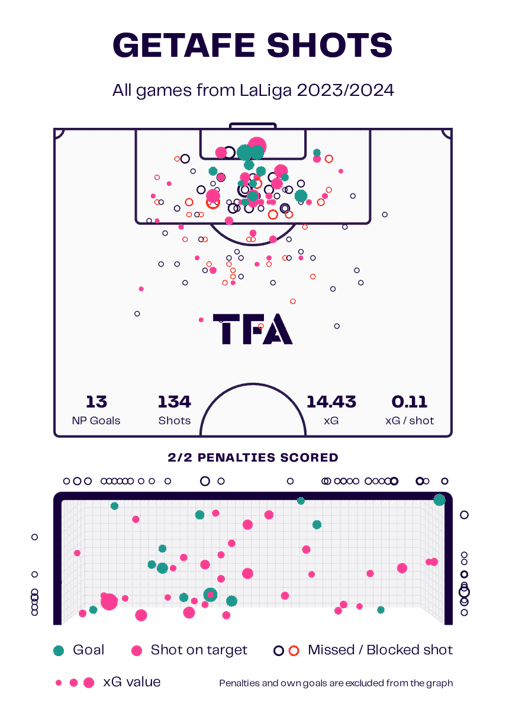
Two of Getafe’s goals this season were scored from the penalty spot, leaving them with 13 non-penalty goals — not a terrible tally from 13 games, but certainly something to improve upon if they’re to maintain their positive start to the league season. Getafe’s goal tally is close to their xG total of 14.43, so their goal tally is a fair reflection of their attacking activity thus far.
Their shot rate is also on the low end of the scale: 9.06 shots per 90 is La Liga’s sixth-lowest rate; incredibly, though, their tally of 37 headed shots is the league’s second-highest! Borja Mayoral and Juanmi Latasa have scored two headers this season, with a cluster of other players contributing to headed goals.
As we mentioned, nine of those 13 have been headers, so their execution in plan A is strong, so perhaps developing a plan B in attack should be high on the agenda for Bordalás. Being able to hurt teams with crosses consistently and aerial play is excellent, but just imagine how much more threatening they could be if they had a strong plan B — it would also make them more predictable in attack.
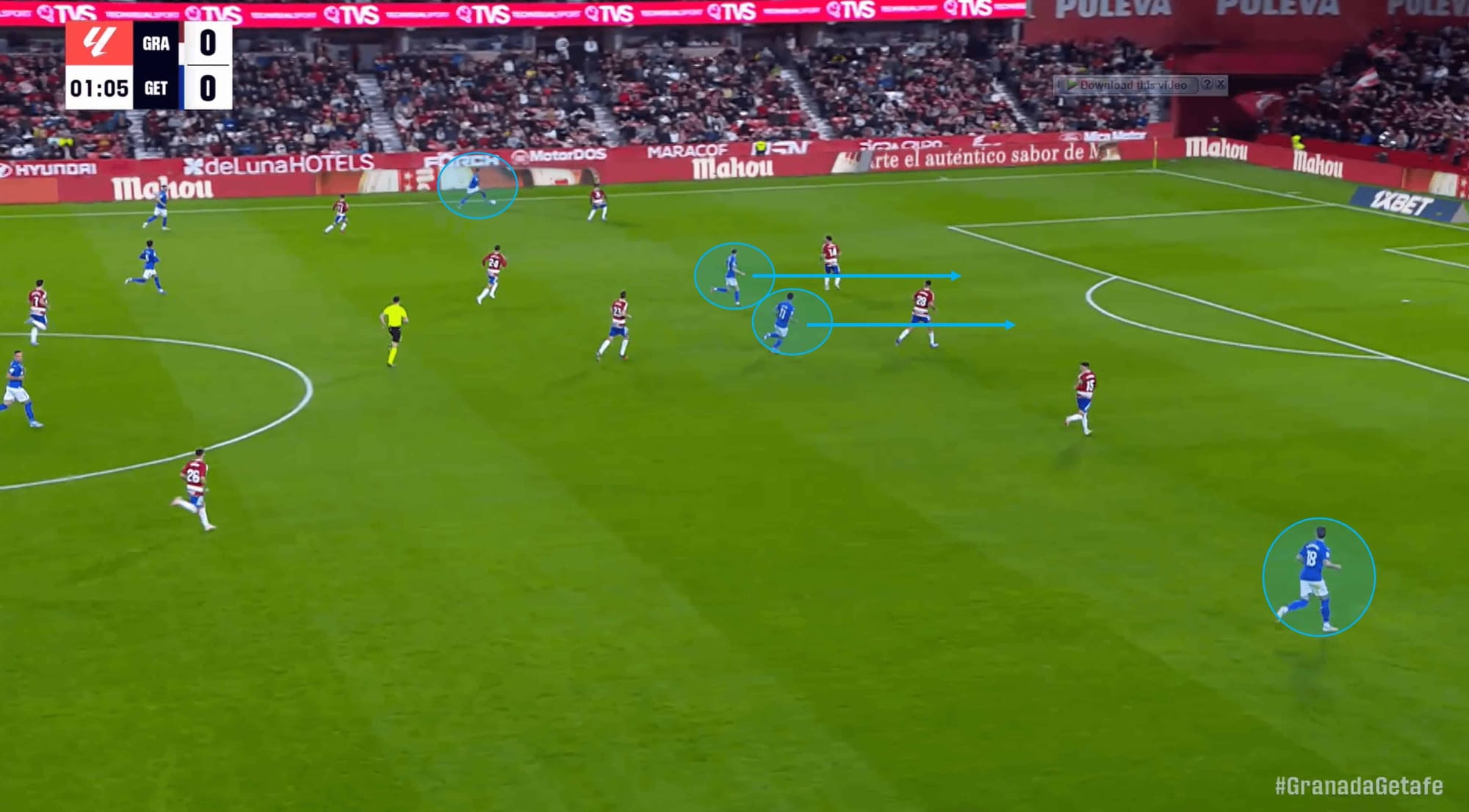
Maintaining possession isn’t a primary concern for Getafe. They rank second-lowest for possession in La Liga, averaging 41.5% per 90. It is clearly a tactical decision to play this way – not only are they dangerous in attacking transitions, but they’re also reaping the rewards in defence too, having conceded 17 goals in 13 games, a number that may sound poor but is better than many teams around them in the table.
When they have the ball, they aim to move into the final third as quickly as possible, with all areas of midfield playing an important role. We’ll get into more details about those roles later. Still, in a nutshell, the wingers look to give Getafe width on both flanks, stretching the opponent and creating more space in central areas for the front two (and sometimes accompanying midfielders) to play with as the attack reaches the box.
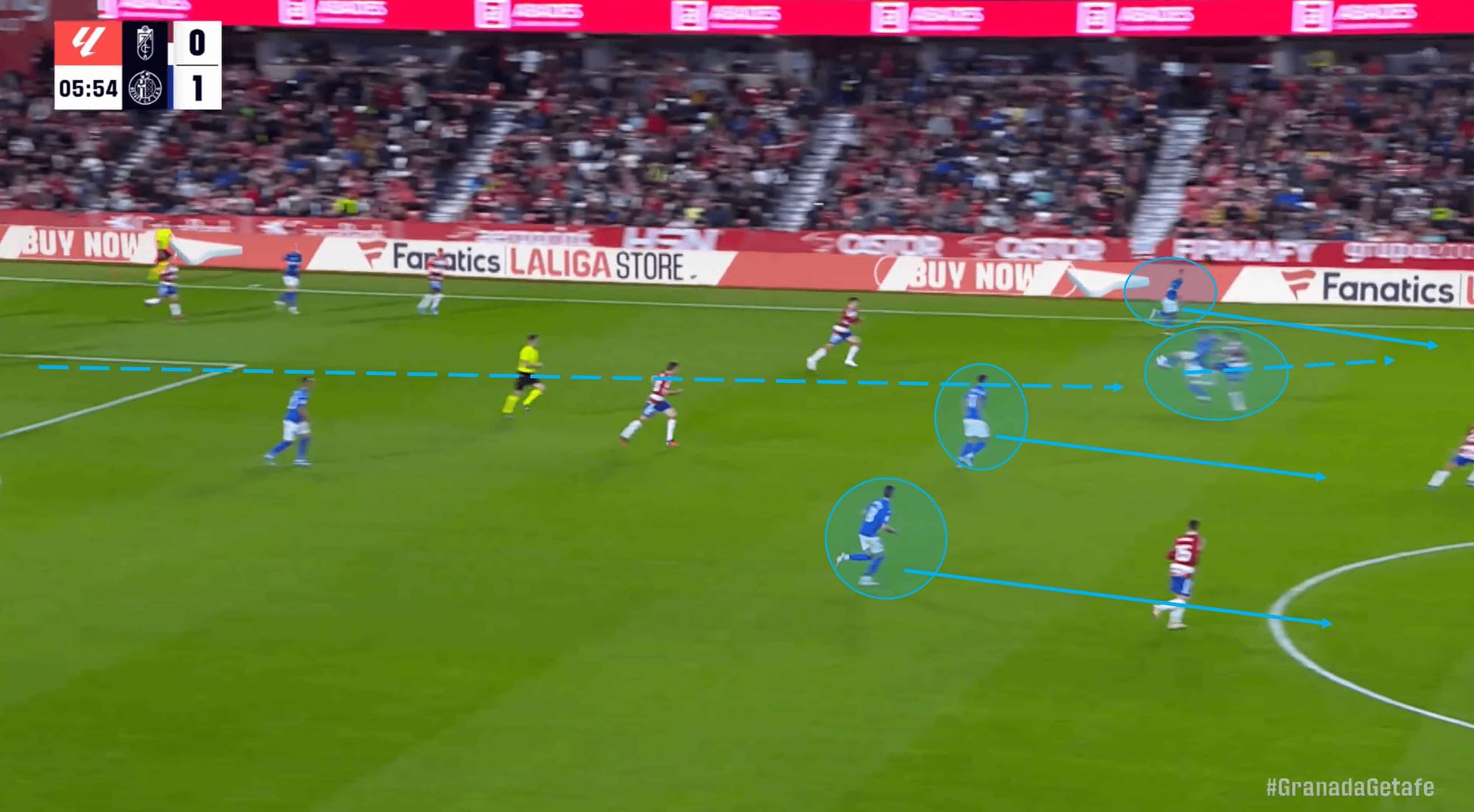
Getafe are no strangers to a counterattack, with the approach of their fast-moving attack we just discussed containing transferable skills, meaning they can get out of danger quickly to launch a dangerous move of their own.
As you would imagine, for a team that enjoys aerial battles, Getafe’s strikers bring a physical presence which lends itself to counterattacking scenarios. Often, a CF, usually Borja Mayoral, will drop in deep to make himself available as an outlet.
At the same time, his teammates in midfield will burst forward to try and outnumber the opposition in their own half, with Mayoral looking to flick the ball on quickly to one of the runners before rejoining the attacking presence.
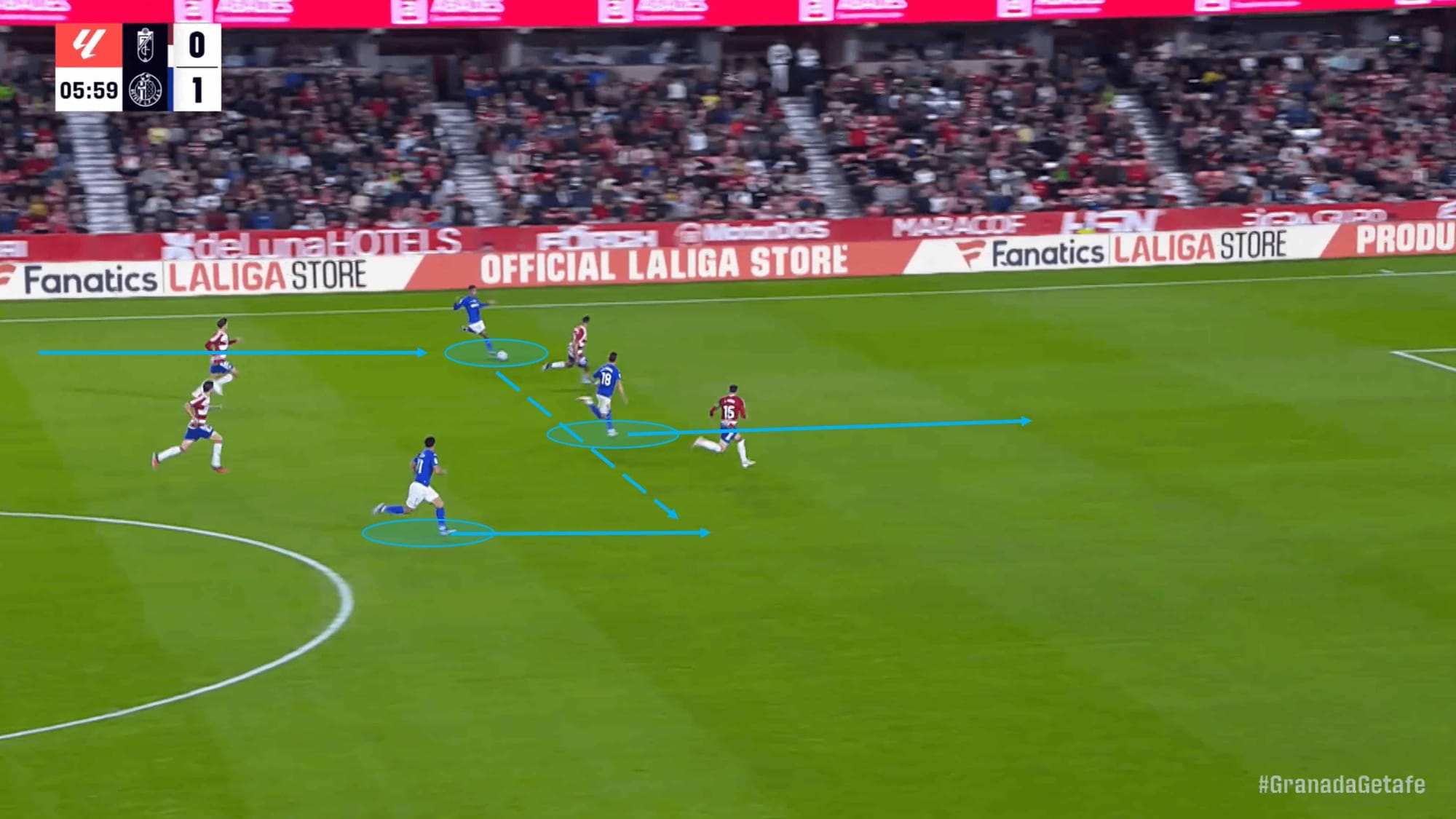
Getafe’s attacking presence in counterattacks depends on the match situation as it does for any other team. As you can see, they are 1-0 away from home after just six minutes in the example above, so sending numerous players forward in a counterattacking frenzy would not be wise.
However, they still pose a significant threat with just three players involved, thanks to good off-the-ball movement and strong team cohesion.
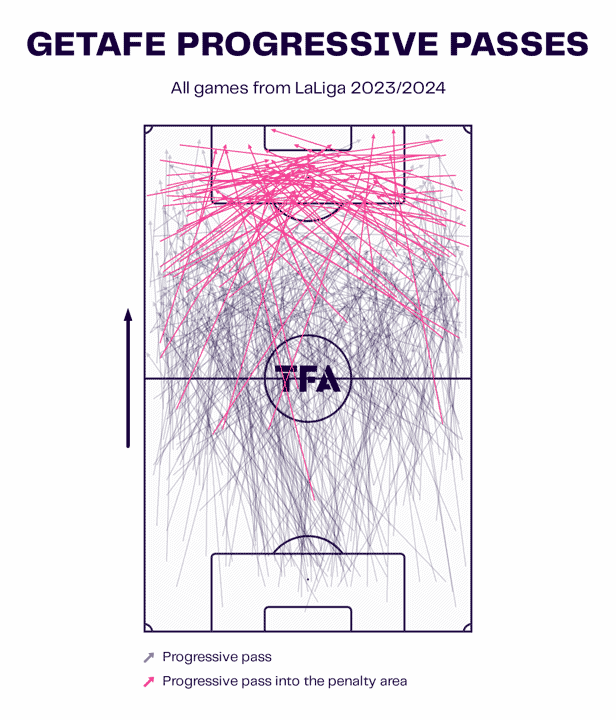
Progressive passes are a way of measuring a team’s frequency in moving the ball significantly closer to goal with long passes and is another area of strength for Bordalás and his team. While they sit just below the league average for the number of attempts, their accuracy rate of 75.4% is only bettered by Real Madrid and Barcelona in La Liga, so Getafe can hold their heads high knowing they are experts in executing progressive passes.
Further evidence of their direct approach lies in some exciting metrics. Getafe’s passing rate currently sits at 11.2, the league’s lowest, meaning they have the lowest number of passes per minute of possession, pointing to a direct approach. Geta Azulones are well acquainted with long passes in general, averaging 45.43 per 90 (La Liga’s second-highest), of which they are accurate 57.9% of the time, leaving them eighth in the rankings for long pass accuracy in La Liga.
When looking at the outfield players who contribute to long passes, Getafe have a few talented individuals. Domingos Duarte sits third in the squad’s accuracy rankings for long passes, hitting 68.57% of his 4.96 long passes per 90 – their GK and Mayoral (CF with low passing average rate) sit above him in the accuracy ratings. Furthermore, Oscar Rodriguez also contributes well, averaging 6.18 per 90 with an accuracy rate of 57.14%.
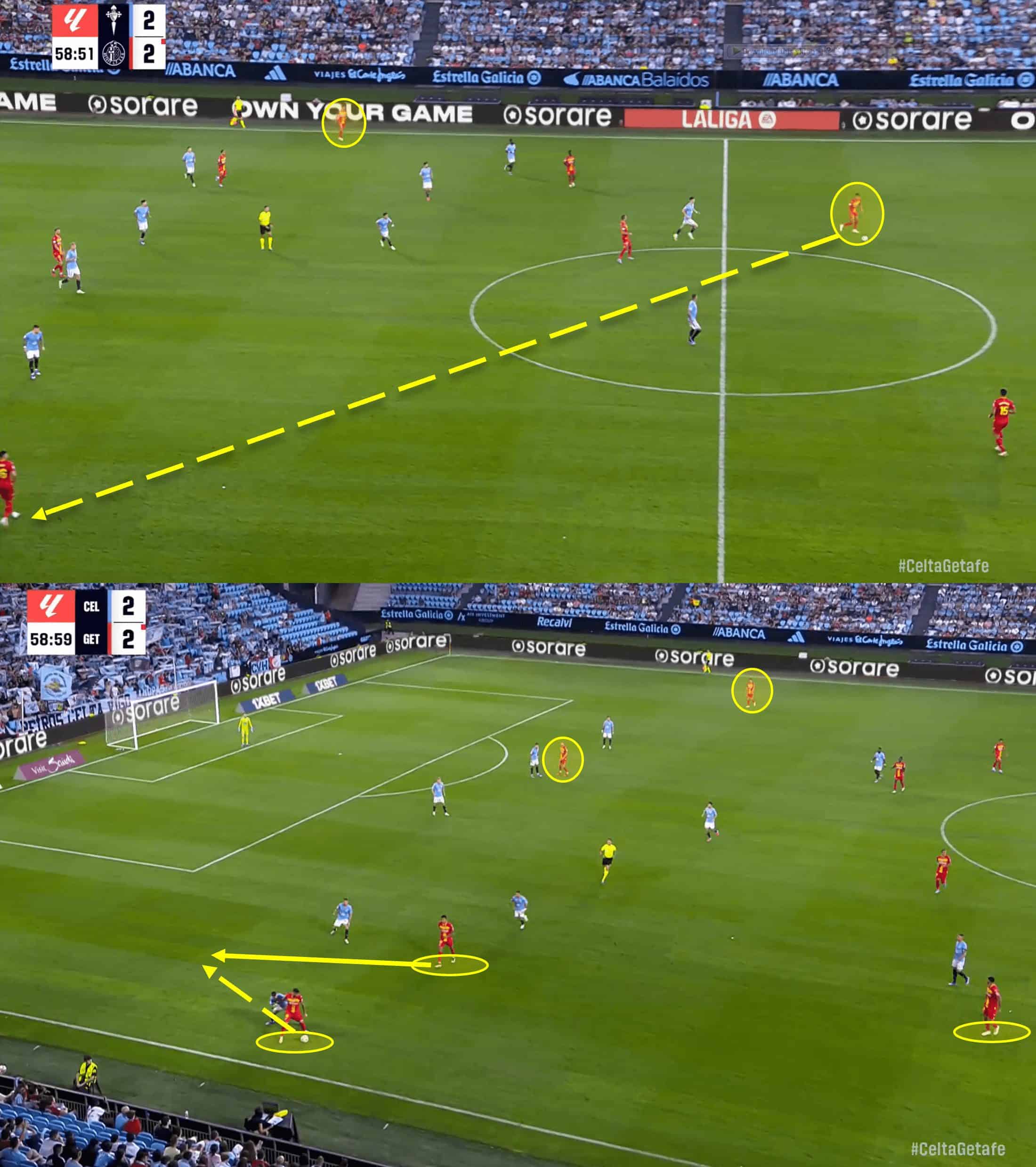
Long passes targeting wide areas from central positions aren’t groundbreaking, but they are essential to Getafe’s tactics and use them effectively. One situation in which see such a move is after the opposition have defended an initial attacking approach from Getafe, but Geta Azulones have another shot at possession.
As we have established, they waste no time in moving the ball forward, and a quick diagonal pass out to the flank is an excellent way to move the ball forward quickly if the receiving player can bring the ball under control and has adequate support around him as the player does in the example above.
Moving the ball quickly down the flank keeps the momentum going, while Getafe’s overall shape maintains width because the players on the opposite flank stay wide, allowing them to run in at the back post to attack the cross.
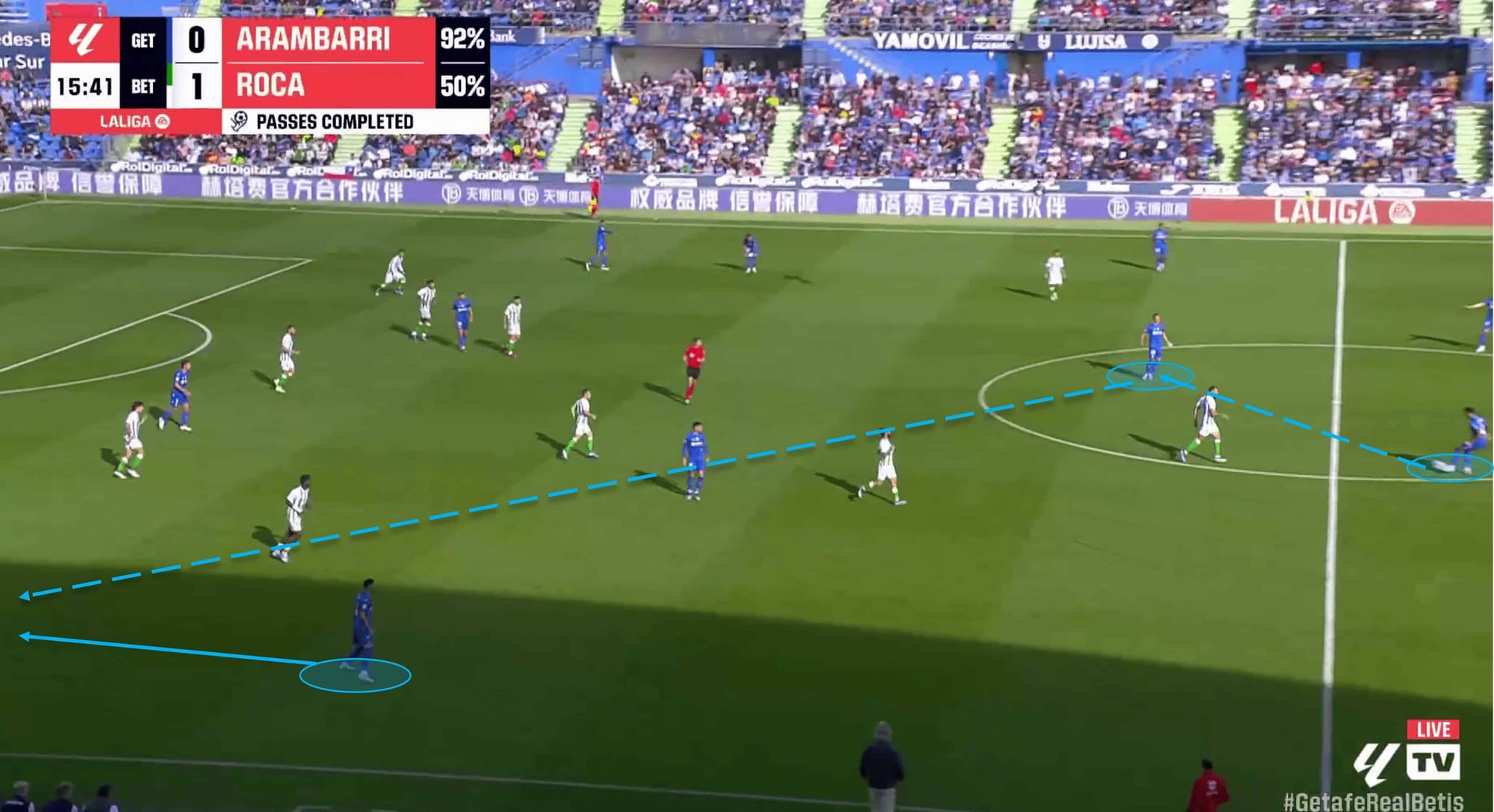
The following example is slightly different to the previous one once we get past the base information of a central long pass out to the flank.
When Getafe have possession and the opposition has been forced into a deeper defensive position, a central midfielder will often look to get into space to receive the ball before he then executes a pass out to either flank.
Generally speaking, central midfielders are more skilled in passing range, which could be why Getafe takes this approach rather than just allowing the CB to play the pass.
Set-piece danger
Being competitive in aerial situations is critical to Getafe’s style of play, so it comes as no surprise that they are a significant threat from corners.
In general, aerial battles are a staple for Bordalás’ team, both in defence and attack, as evidenced by their 45.17 aerial duels per 90, which is La Liga’s highest average this season (they also have a success rate of 46% which is higher than the league average).
They’ve taken that sort of dominance into set-pieces – it is evident that corners are something they work at on the training pitch, and in this segment, we will look at some examples of their corners and highlight a critical routine that has brought them the most success.
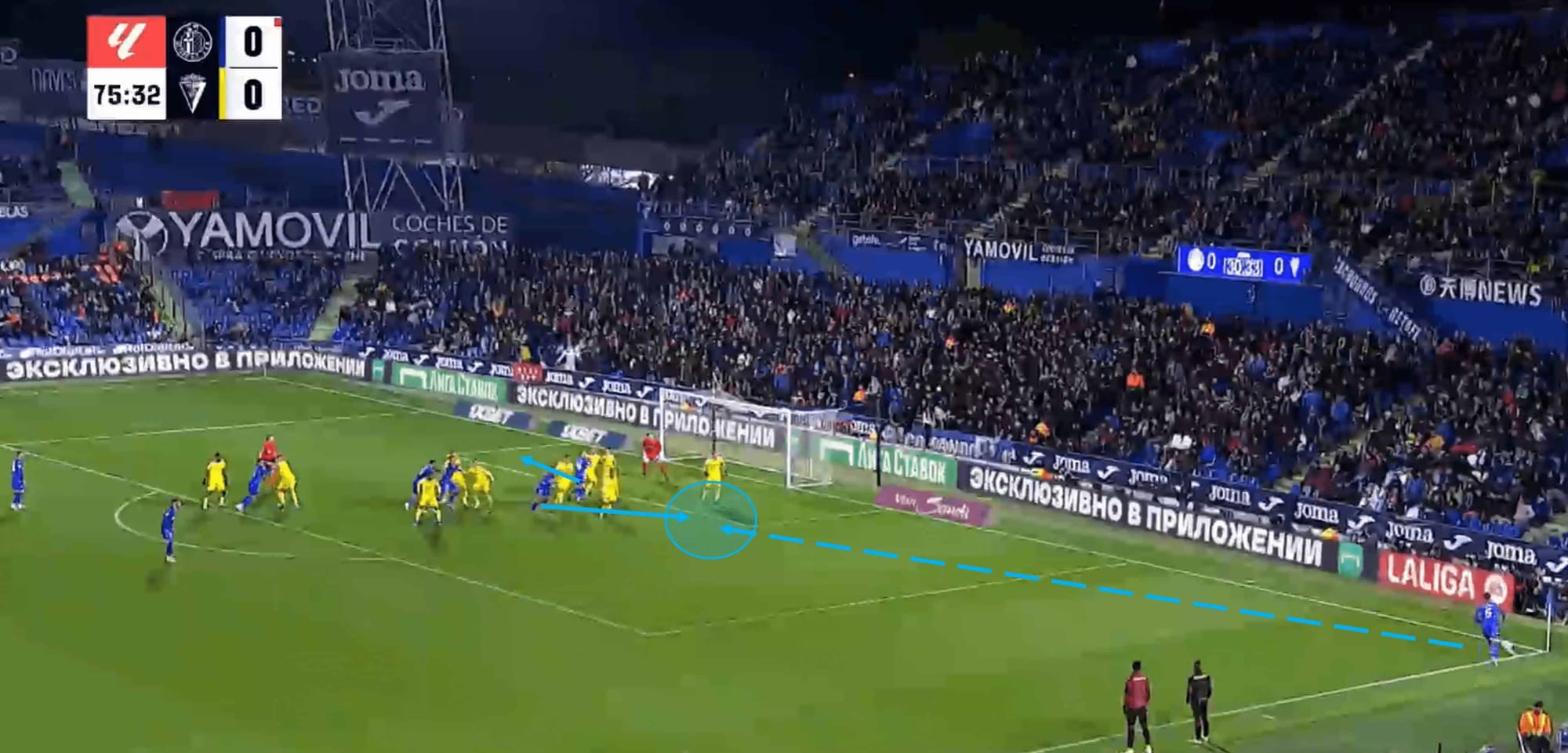
You’ll notice a theme in the corners we analyse in this scout report: Getafe attacking the near post. Geta Azulones have scored four times from corners this season, so we know they are a real threat from these set pieces. Having aerial ability is one thing, but working on routines with set patterns will really help bring consistent results.
Interestingly, the tendency to attack corners does not rely on the taker of the corner. As you can see, this corner is being delivered as an outswinger, but the clever movement in the box – two towards the near side of the box and the remaining players making individual movements to provide further disruption. The goal was not scored via a front post header, however. Notice the Getafe player drifting toward the back post – he was there anticipating the flick-on header, which came, giving him a tap-in.
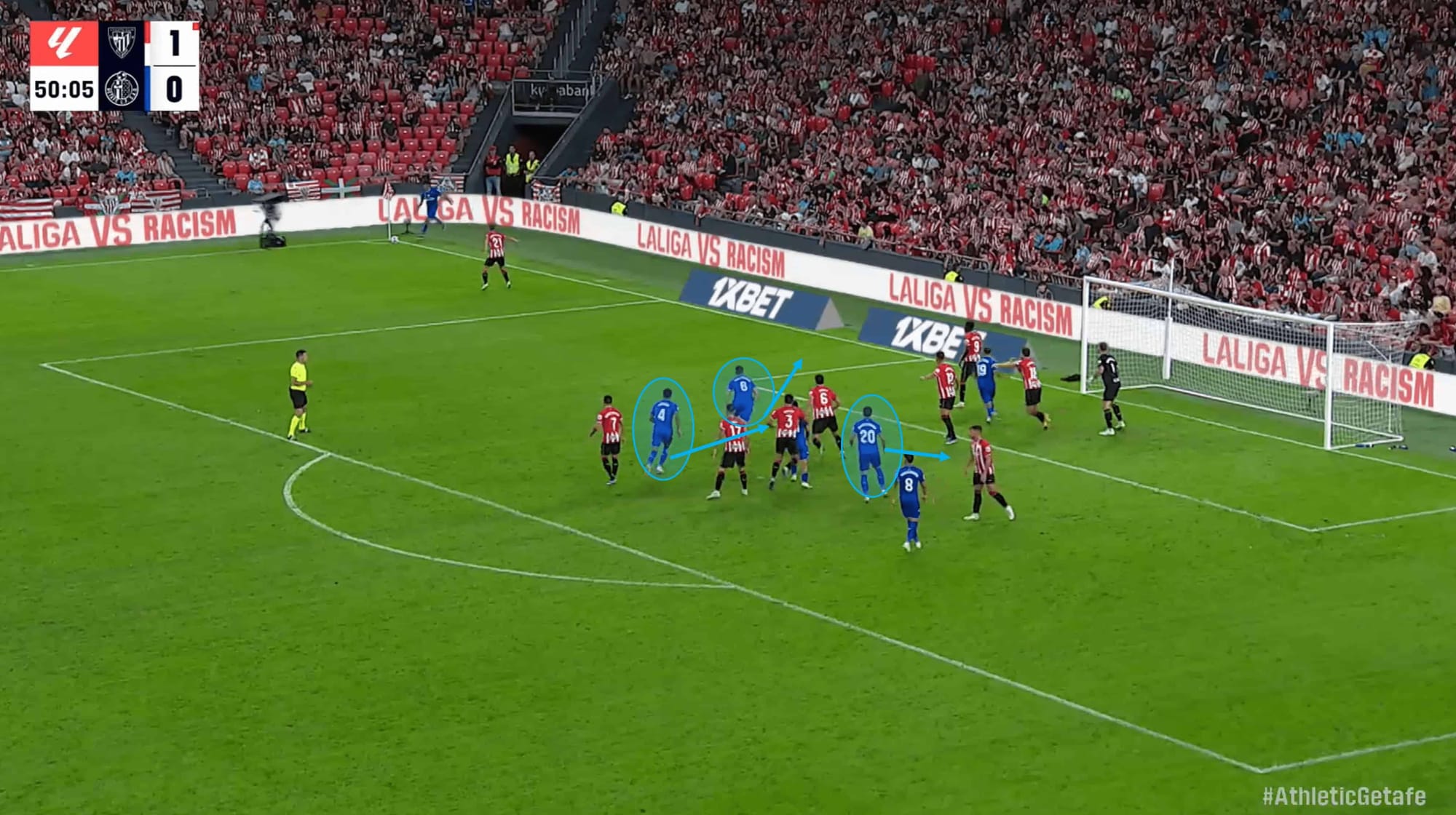
Another dangerous corner that targeted the near side, this time from the opposite flank with an inswinging delivery. We can see the positioning more clearly in this image, giving us more insight into the pattern of the set piece.
Number four, Gastón Álvarez, was the scorer of this particular corner – while the teammate in front of him dashed towards the corner of the six-yard box, Álvarez took up a slightly more central position to meet the cross with a header. Additionally, there was further movement from Getafe, with Nemanja Maksimovic drifting toward the far side of the six-yard box.
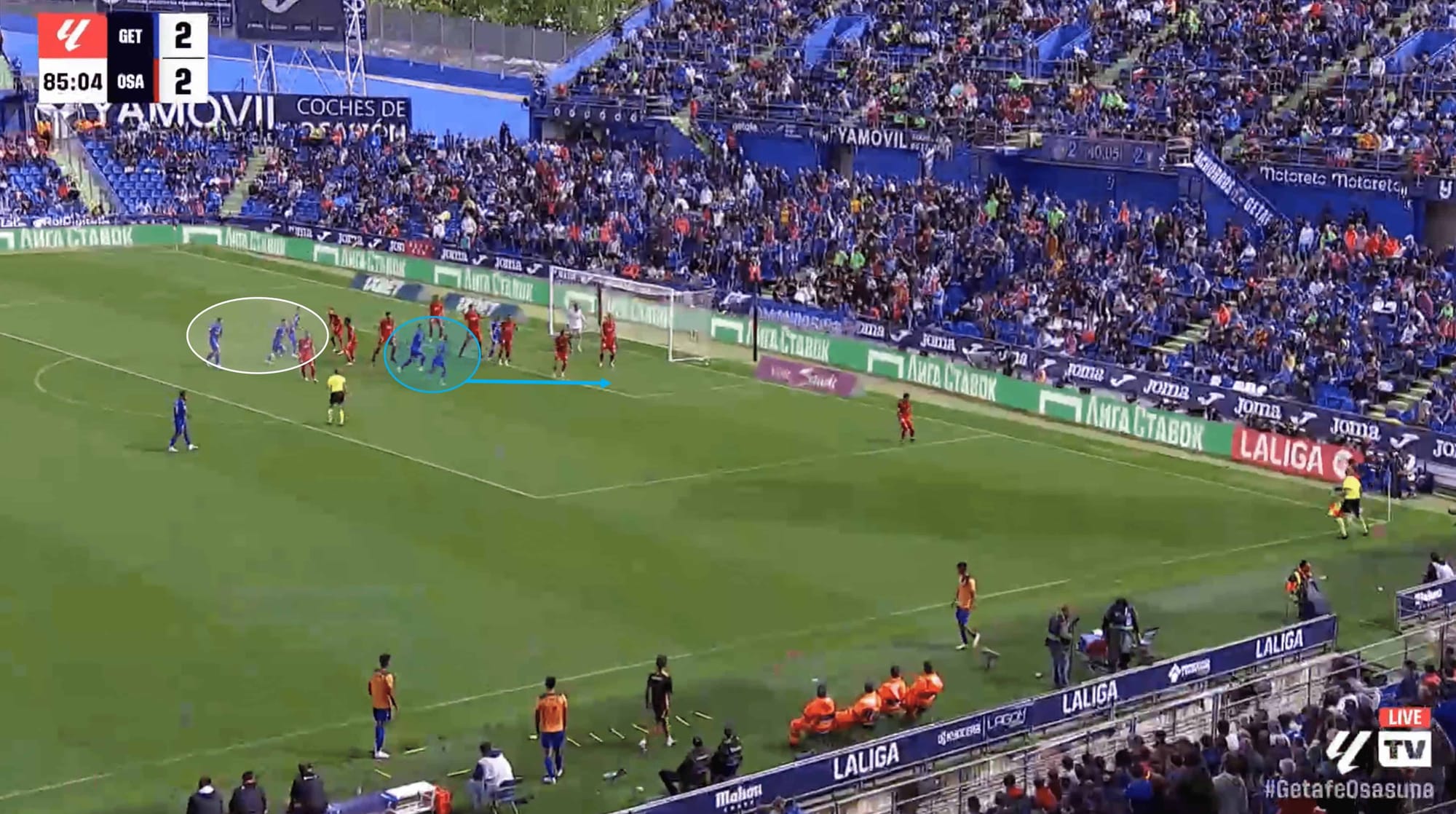
A third and final example of their near-post corner routine. Again, they have two players making the move to the corner of the six-yard box, but the movement behind them took a slightly different nature due to the defensive presence and positioning. Instead of a more structured approach, they started deep before splitting, each making individual runs into a dangerous area, making it very difficult to track and mark for the opposition.
Crossing masterclass
Getafe aren’t just dangerous from corners and crosses in open play. Crossing is Getafe’s primary weapon in getting the ball into dangerous areas, which matches their quick approach.
They average 11.86 touches in the box per 90, which is the lowest in La Liga, but this does not show a struggle in reaching the box necessarily, but suggests that their build-up phase often ends once the ball enters the box – they like to get shots off quickly once in the area, which helps with their high crossing rates.
This final analysis segment looks at why they are so dangerous from crossing situations – how they build their possession into crossing areas consistently and the activity within the box that makes them so clinical in those moments.
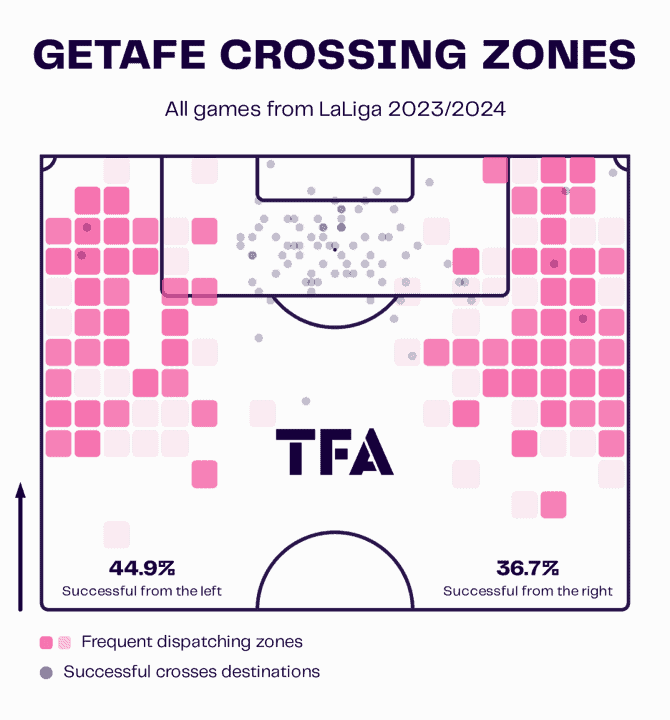
While eight teams average more crosses than them, Getafe are undisputed in their execution – their cross accuracy of 40.6% is the highest in La Liga, indicating an apparent strength in this area of attack, and they score a high proportion of their goals from crosses.
Breaking down their crossing frequency, there is more activity on the right flank, particularly near the byline, but they find more success when crossing from the left flank. As you can see from the visual above, they also have a strong frequency in crossing from areas just inside the flank — not quite central but not quite wide either — we see some examples of them in the analysis that follows.
Regarding individual crossing contributions, their most frequent crosser, on average, is Fabrizio Angileri, their 29-year-old Argentinian left-back, who can also play in a left midfield role. He has only featured three times this season but averages 3.87 crosses per 90, the highest outfield rank in the Getafe squad. He also has a high accuracy rate of 50%, so he can likely play an essential role throughout the season. Other regular crossers include Juan Inglesias, Portu, and Diego Rico.
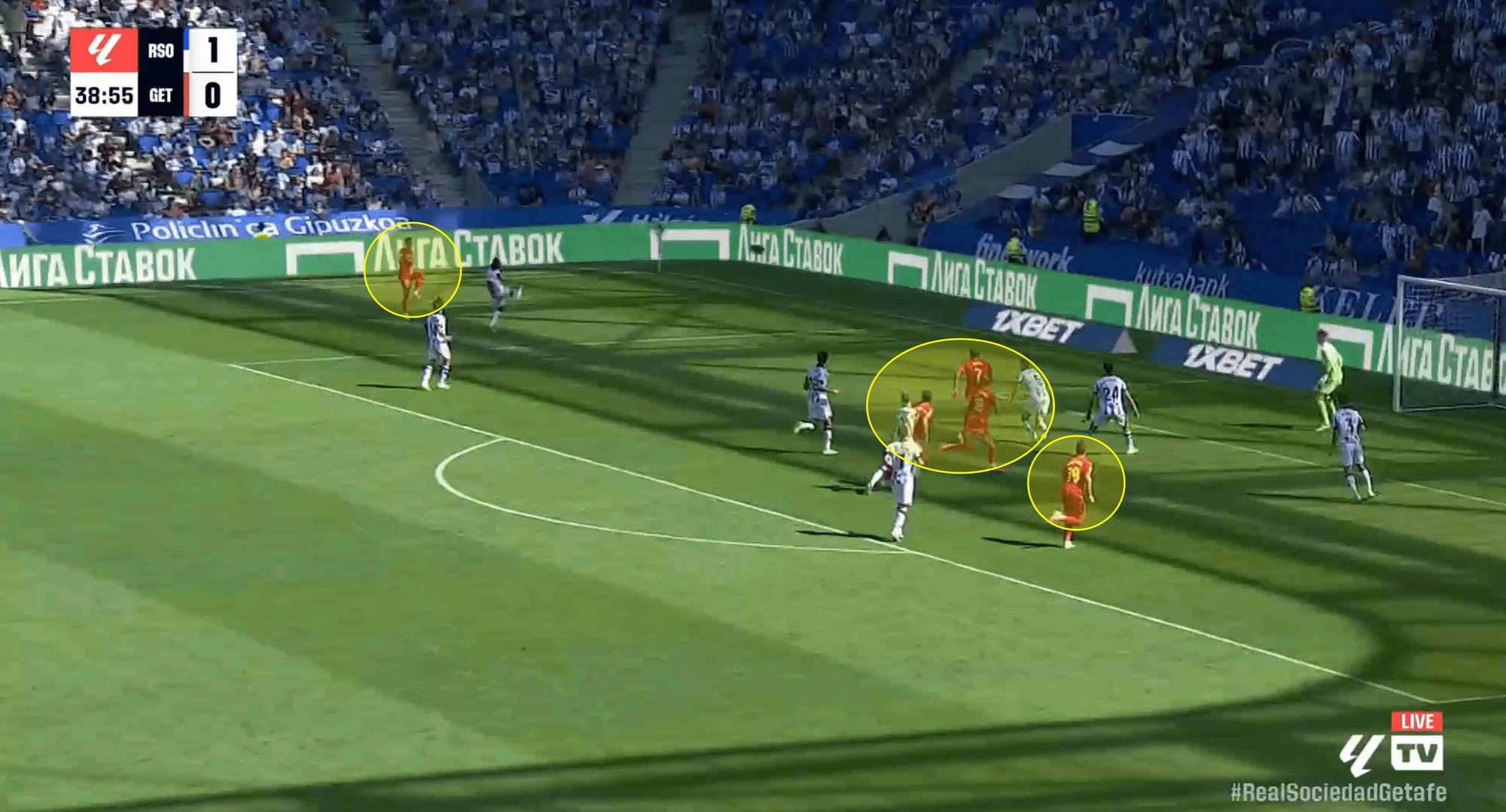
Our first example looks at a cross from a wide position past the 18-yard line. Instead of looking to take the opponent on, the Getafe player opts to get the ball into the box – a wise decision considering they have four options. Just like their activity from corners, their movement within the box aims to disrupt the opposition while also giving the crosser plenty of options to target.
As we discussed earlier, crossing in quickly is likely contributing to the squad’s low passing rate. Where possession-based teams may look to play a few passes between the supporting full-back and midfielder, Getafe are rarely interested in that and just wish to cross the ball into a heavy attacking presence.
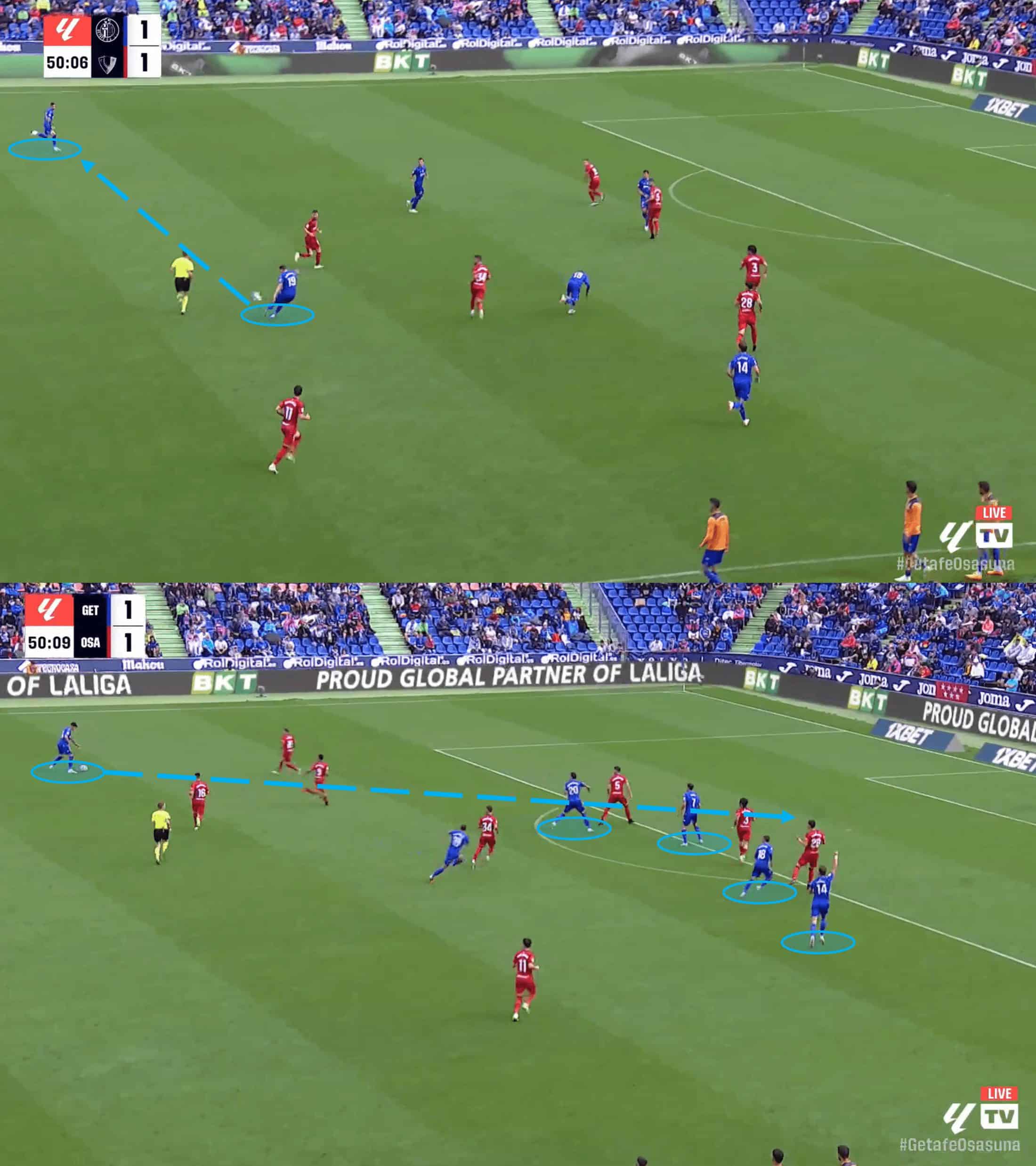
As we mentioned earlier, Getafe like to put in early crosses from deep positions, and this action is not taken on a whim. We know this because, as you can see above, there is a high attacking presence heading into the box, anticipating a cross from a slightly deeper area.
The sheer numbers involved in this attack in terms of players making themselves a crossing target, rather than players dropping in to make close passing options to the crosser, shows that it’s something Bordalás really believes in.
The runs from the players are interesting, too – movement in the box is a reoccurring theme for Getafe – they have players running near post far post, covering all bases while also looking to attack the gaps between opposition defenders.
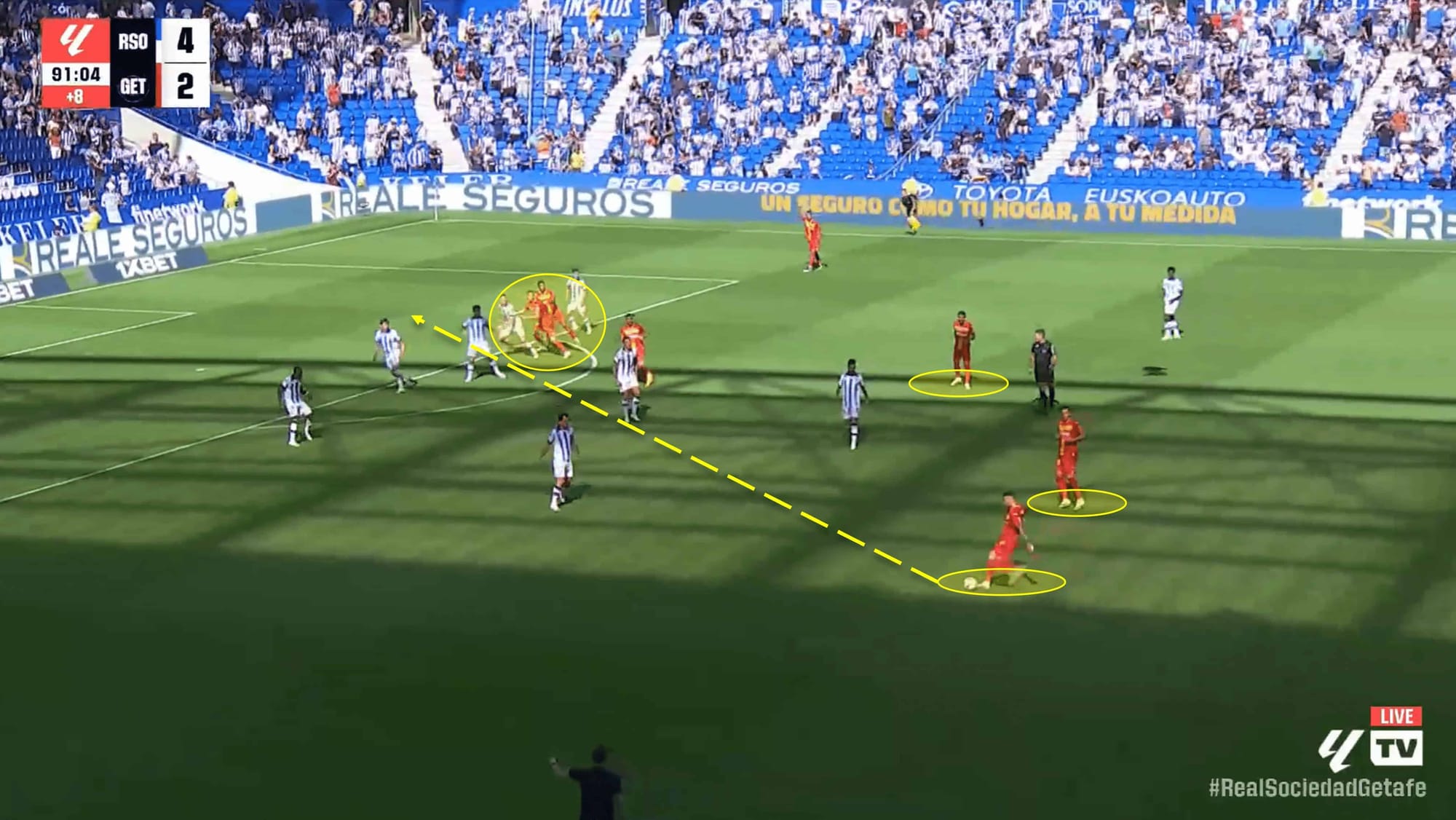
This final example touches on something we spoke briefly about earlier when looking at Getafe’s crossing zones, which is the tendency to cross from slightly more central areas. The tactic shares many similarities to the last image we analysed. They look to quickly deliver the ball into a dangerous area rather than looking to recycle possession or even work the ball into a wider position before crossing.
You are most likely to see this during a second-phase attack after the opposition have already defended the first attacking phase but failed to take control of possession. This is why Getafe’s box presence is slightly lower, numerically speaking, but the runners still look to attack the gaps between defenders.
Another interesting note lies within the positioning of nearby midfielders. While they could be used in a short pass, Getafe, as we have said, like to get the ball forward quickly – but that is not to say they never use that short option. Those midfielders, though, do draw some opponents out from a deeper position so they can quickly close them down if they do get that short pass – in turn, this lessens the defensive presence in and around the penalty area, which is precisely what Getafe desire.
Conclusion
They aren’t having the season that Girona are, but Getafe will be very pleased with how they’ve played and the points they’ve collected in the season’s opening months.
Of course, they have their weaknesses and areas to improve (if they didn’t, they wouldn’t be 11th!), but losing just three times so far this season while also showing some real attacking aerial dominance will please José Bordalás.
While they will look to improve other areas of their attacking play, expect a continuation of their strong physical and aerial tactics.






Comments